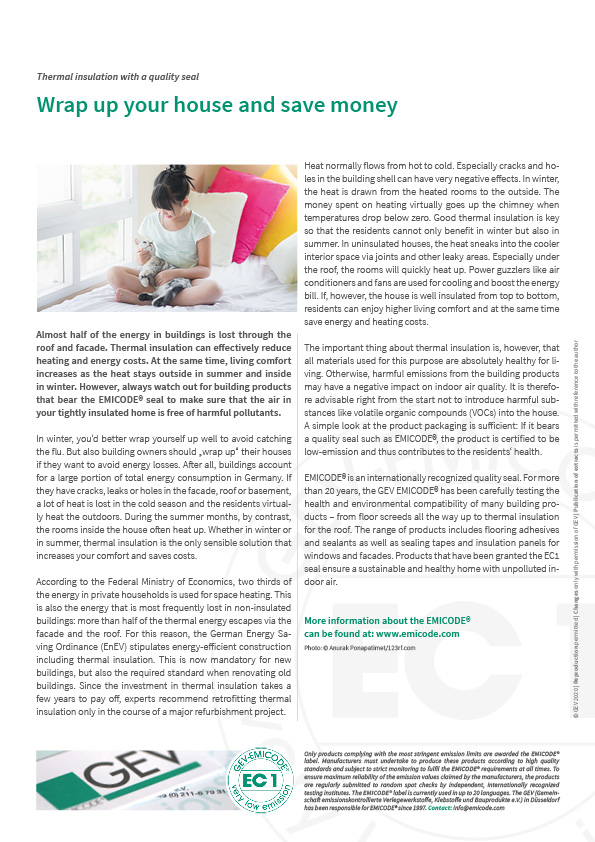Wrap up your house and save money
Thermal insulation with a quality seal
In winter, you’d better wrap yourself up well to avoid catching the flu. But also building owners should “wrap up” their houses if they want to avoid energy losses. After all, buildings account for a large portion of total energy consumption in Germany. If they have cracks, leaks or holes in the facade, roof or basement, a lot of heat is lost in the cold season and the residents virtually heat the outdoors. During the summer months, by contrast, the rooms inside the house often heat up. Whether in winter or in summer, thermal insulation is the only sensible solution that increases your comfort and saves costs.
According to the Federal Ministry of Economics, two thirds of the energy in private households is used for space heating. This is also the energy that is most frequently lost in non-insulated buildings: more than half of the thermal energy escapes via the facade and the roof. For this reason, the German Energy Saving Ordinance (EnEV) stipulates energy-efficient construction including thermal insulation. This is now mandatory for new buildings, but also the required standard when renovating old buildings. Since the investment in thermal insulation takes a few years to pay off, experts recommend retrofitting thermal insulation only in the course of a major refurbishment project.
Heat normally flows from hot to cold. Especially cracks and holes in the building shell can have very negative effects. In winter, the heat is drawn from the heated rooms to the outside. The money spent on heating virtually goes up the chimney when temperatures drop below zero. Good thermal insulation is key so that the residents cannot only benefit in winter but also in summer. In uninsulated houses, the heat sneaks into the cooler interior space via joints and other leaky areas. Especially under the roof, the rooms will quickly heat up. Power guzzlers like air conditioners and fans are used for cooling and boost the energy bill. If, however, the house is well insulated from top to bottom, residents can enjoy higher living comfort and at the same time save energy and heating costs.
The important thing about thermal insulation is, however, that all materials used for this purpose are absolutely healthy for living. Otherwise, harmful emissions from the building products may have a negative impact on indoor air quality. It is therefore advisable right from the start not to introduce harmful substances like volatile organic compounds (VOCs) into the house. A simple look at the product packaging is sufficient: If it bears a quality seal such as EMICODE®, the product is certified to be low-emission and thus contributes to the residents’ health.
EMICODE® is an internationally recognized quality seal. For more than 20 years, the GEV EMICODE® has been carefully testing the health and environmental compatibility of many building products – from floor screeds all the way up to thermal insulation for the roof. The range of products includes flooring adhesives and sealants as well as sealing tapes and insulation panels for windows and facades. Products that have been granted the EC1 seal ensure a sustainable and healthy home with unpolluted indoor air.

Photo: @Anurak Ponapatimet/123rf.com
Almost half of the energy in buildings is lost through the roof and facade. Thermal insulation can effectively reduce heating and energy costs. At the same time, living comfort increases as the heat stays outside in summer and inside in winter. However, always watch out for building products that bear the EMICODE® seal to make sure that the air in your tightly insulated home is free of harmful pollutants.

Do You Have Questions?
If you have questions about specific topics or if you would like to contact us for any other reason, feel free to contact us by phone, fax or e‑mail.
Phone: +49 211 / 67931–20
Fax: +49 211 / 67931–33
info@emicode.com
Share article on Social Media:
